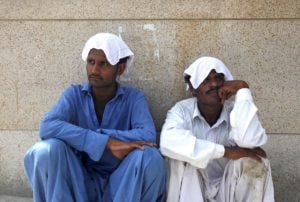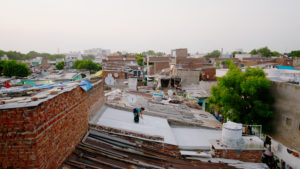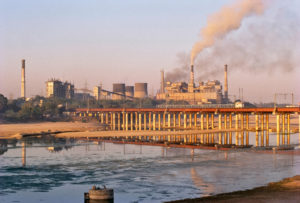The heatwave currently bearing down on the Indian subcontinent has made headlines around the world for the threat it poses to the health and livelihoods of millions of people, with doctors reporting a rise in heatstroke symptoms and warning that prolonged exposure to such extreme conditions can be deadly.
But what is also being exposed is a lesser-known vulnerability: that of an energy system that quickly gets strained beyond its maximum capacity when there is a dramatic rise in demand for power to keep ACs, fans and fridges going in homes and hospitals when it’s too hot outside.
Temperatures touching the mid-to-high 40s (degrees Celsius) are not usually seen in north India and Pakistan before May, but this year they started in the second week of April, stretching the hot season by weeks. The unseasonal heat has alarmed scientists, who say it carries the footprint of climate change. Mariam Zachariah, a climate scientist at the Grantham Institute at Imperial College London in the UK, says that the temperatures in South Asia at the moment are “uncanny”.
The footprint of climate change
With her team, she examined the heatwave spell that occurred from the first week of April, finding that such temperatures are now roughly a one-in-four year event in the current climate. They compared this with a computer-generated model planet, with lower greenhouse gas emissions in the atmosphere, and found that without climate change such events would have been very rare, occurring just twice in a century.
“Following this pattern, we can expect heatwaves with hotter temperatures to become more common in the future, until net emissions [emissions of greenhouse gases above net zero] are halted,” Zachariah says.
This persistent heatwave shows climate change is real and therefore decarbonisation of the grid is imperativePolicy lead of a renewable energy company
As the mercury went up across north and central India, the power started going out just when it was needed the most – not just to cool homes, but also to keep agricultural pumps going so they can draw underground water and irrigate parched crops in the states of Haryana and Punjab, the country’s breadbasket. The pollster LocalCircles surveyed 21,500 households across 322 rural and urban districts, finding that two out of three respondents have faced power outages during the heatwave, and one in three experienced power outages that were over two hours long. Data from the national load dispatch centre (POSOCO) records power shortages in various states.
What happens to the grid
Power cuts happen when energy demand exceeds what grid operators were expecting and had planned to dispatch at a certain time, explains Chandana Sasidharan, a senior researcher with the think tank Alliance for an Energy Efficient Economy (AEEE). Last week, India registered an unprecedented 207,111 MW peak power demand, nearly tipping the energy system out of kilter.
“[The grid] works on a system of balance, supply needs to match demand at any given time,” she explains. “Now, when you have any climate extreme event, just like a heatwave, how do you prepare for that? You would look at what happened last year in the same month, and you’ll also look at what happened in the previous week [to gauge energy consumption patterns].” Energy planners know the demand is going to increase, “but what you don’t have control over is the scale of this increase. Demand has a lot of behavioural aspects, and you really can’t predict it with too much granularity.”
Had there been proper planning there’s enough capacity in the systemPolicy lead of a renewable energy company
“The stumbling block in this situation was poor planning by the power distribution companies,” says the policy lead at one of India’s leading renewable energy companies, who asked to remain anonymous. “No one anticipated such a rapid increase in peak demand at the back of the heatwave conditions, but had there been proper planning there’s enough capacity in the system,” the expert says. “My experience shows that demand estimation so far is manual and Excel-based, devoid of scientific techniques, not using weather prediction models in any way.”
Private distribution companies fared better, the expert adds, because they use more sophisticated tools to work out how much energy will be needed at any given time.
An urgent and complex energy transition
Climate change and the need to move away from coal are adding to the challenge. With increasingly severe heatwaves the need for air conditioners and fans will grow, but as long as this additional energy is procured via fossil fuels, it will contribute to the problem in the long term. “This persistent heatwave shows climate change is real and therefore decarbonisation of the grid is imperative,” says the policy lead, adding that the push towards manufacturing of solar cells and modules, batteries and now hydrogen can also help make India more energy secure in the face of geopolitical turmoil.
34 million jobs
will be lost in India due to heatwaves by 2030, the UN predicts
Renewables will bring a paradigm shift in the way energy planners operate, Sasidharan says. “With fossil fuels such as coal you could fully control your energy flows, all you had to do was to increase coal power capacity [to produce the exact amount of energy needed].” When dealing with solar “you have no control over the input”, because energy production will fluctuate with the weather and stop at night.
One short-term intervention for a power sector under stress is to identify critical infrastructure such as hospitals and focus on avoiding interruptions there in case of extreme weather, Sasidharan says. But in the long term, there is a need for a more holistic approach which involves managing demand too, incentivising people to use their energy more efficiently – for example keeping the air conditioner at 26C degrees instead of 18C.
Heatwaves may only make the headlines once a year, but adapting to the impacts of a warming planet is now a year-round challenge. According to the UN, heatwaves are going to cost India 34 million jobs by 2030, particularly in the construction and agricultural sector, the backbone of the country’s labour market.
Abinash Mohanty, programme lead with the Delhi-based Council on Energy, Environment and Water (CEEW), says that preparing for extreme temperatures requires a wide range of hyper-local interventions, including designing roofs that absorb less light and retain less heat, improving early warning systems and implementing nature-based solutions such as restoring tree cover as much as possible.
These measures will in turn reduce the need for electric cooling, helping save energy and protecting those who can’t afford fans or air conditioners. “Fast-tracking heatwave action plans will ensure the climate-proofing of India’s economy as well as improving quality of life for its citizens,” he says.
This article was first published by Lights On




![Construction workers in India are particularly vulnerable to heat waves [image: Alamy]](https://dialogue.earth/content/uploads/2020/08/HWRY8G-300x179.jpg)




